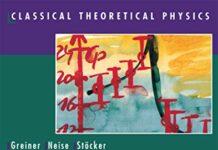
Ebook Info
- Published:
- Number of pages:
- Format: PDF
- File Size: 3.07 MB
- Authors: Walter Greiner
Description
Gauge Theory of Weak Interactions treats the unification of electromagnetic and weak interactions and considers related phenomena. First, the Fermi theory of beta decay is presented, followed by a discussion of parity violation, clarifying the importance of symmetries. Then the concept of a spontaneously broken gauge theory is introduced, and all necessary mathematical tools are carefully developed. The “standard model” of unified electroweak interactions is thoroughly discussed including current developments. The final chapter contains an introduction to unified theories of strong and electroweak interactions. Numerous solved examples and problems make this volume uniquely suited as a text for an advanced course. This fourth edition has been carefully revised.
User’s Reviews
Reviews from Amazon users which were colected at the time this book was published on the website:
⭐As of early 2006, this is the best available choice for a text on the standard model of the weak force, and the possibilities for its upgrade with the new neutrino discoveries.The minimum requirements for a reader are an advanced knowledge of engineering-level calculus, basic quantum theory, and great familiarity of the sub-atomic zoo and quantum number bookkeeping.The volume has occasional errors, like reversing the assignment of the Kayon |Ks> and |KL> mixed states to the symmetric (should be anti-) and antisymmetric (should be sym.) combination of K0 and anti-K0. The math is right, but the explication in the text is wrong. Similar small errors popped up throughout the text, which was annoying in a 3rd edition.The authors do give a very good overview of (most) possible prior and new versions of the standard model, but for an edition published late in 2000 I expected a lot more about adaptions that accounted well for neutrino mass. There is some there, just not as much as I’d like. I’m hoping in the 4th edition that there will be more discussion on the connundrum of the weak force’s preference for left-handed chirality (all the more bizzare now that neutrinos are now thought to have mass). It will be several years before anyone publishes a successor text, since theorizing is still underway, and most particle physicists will be inclined to save their ink until after they’ve seen results from CERN’s new Large Hadron Collider (LHC), to startup in 2007. I reckon that research and textbook writing delays will keep this book current until at least 2009.The text occasionally has superb, succinct explanations of problems and motivation, but is given to long mathematical digressions into admittedly important crossection derivations. I wanted more chit-chat with my math. It also made disturbingly abrupt jumps in subject, however, the line of reasoning is very orderly, so it’s possible to catch up with the authors. The technical English did bother me: being able to read mathematical German helped me a lot to recognize “what they really meant”, since the English translation occasionally uses the wrong word, or a term depricated in physicist-English. It looks to me like it could benefit from some smoothing out (1) by a single physicist adding more bridge text between sections and (2) technical editing by a native English speaker, to tidy up awkward idiom. On the other hand, if you just want the straight scoop, and can pull it out of the math with a minimum of coddling and survive an occaional simple mistake, this book is for you.It would be nice if there were more diagrams, but on the whole, the number of diagrams and pictures is adequate. A few more would make the math sing.There are occasional biographical notes, which are nice, and the authors give sufficient historical background for the theory, which is good, but best of all is that they do not use “the historical approach” to particle physics. Thank you! The weak interaction is desribed in stages of increasing complexity from minimum adequate to possible next version(s). By coincidence, it’s mostly in historical order, but they don’t waste your time with no longer relevant background. That was excellent.
⭐I’m sorry I was late.The goods were well received. Thank you.
⭐The book is too complicated and, thus, I returned it. It may be acceptablefor some persons.
⭐i like it very much, good goog good good good good good good good good good good good good quality
⭐
⭐
Keywords
Free Download Gauge Theory of Weak Interactions in PDF format
Gauge Theory of Weak Interactions PDF Free Download
Download Gauge Theory of Weak Interactions PDF Free
Gauge Theory of Weak Interactions PDF Free Download
Download Gauge Theory of Weak Interactions PDF
Free Download Ebook Gauge Theory of Weak Interactions



